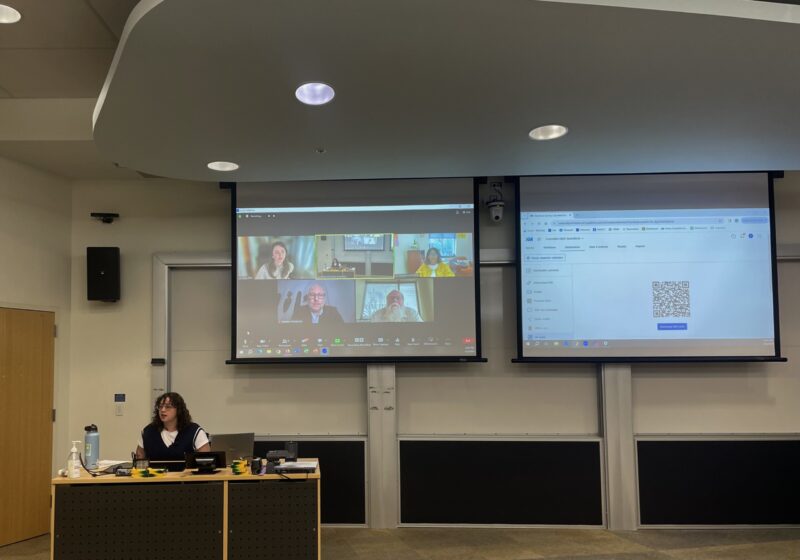Last week’s op-ed, “Science and Faith” by Evan Keegan, rehashed a series of popular myths and unfortunate misconceptions about the nature of science, faith, and knowledge. These myths do believers and unbelievers alike a disservice, but persist because they legitimize religion by tying it to science (curiously, one never observes scientists trying to legitimize science by tying it to religion). This line of fallacious argument usually consists of two steps: 1. Tie science and religion together by labeling them both “beliefs,” an equivocal term that encompasses both facts and opinion, and 2. Claim that science has problems only religion can fix.
Keegan asserts that “everyone can agree that like religion, science is very much a belief as well.” We can all agree that a golf cart and a passenger jet are very much motor vehicles, but I’m not crossing the Atlantic in a golf cart. “1 + 1 = 2,” and “I like poodles” are both beliefs, but are fundamentally different statements. “1 + 1 = 3” can also be a belief—a belief may be about a subjective opinion, an objective fact, or a falsehood. “Science”, in fact, is a method and not a belief.
Science is a gradual but powerful process that takes empirical observations about the world, matches them with systematic explanations, and then refines or throws away such explanations when they contradict evidence. Educated hunches are called “hypotheses,” very-well supported explanations are “theories,” and occasionally something becomes a “law.”
Faith, on the other hand, is a different animal. It, by definition, asks the believer to accept something without a reason. In ancient times, faith began as a series of beliefs to explain the natural world. Organized religions go a step further—they espouse a specific dogma as the truth. Modern religion and spirituality navigate a dilemma: usually, a religious belief is either specific enough that science can disprove it (putting the religion at risk) or vague enough that it is unfalsifiable—meaning that it cannot be disproven even hypothetically and is thus not “knowledge” in a meaningful sense. Successful modern religions must be flexible enough to maintain educated people, but structured enough to fill meaningful social roles.
Religious fundamentalists who refuse to be flexible rely on demonizing science itself and willfully spreading ignorance. This has been and continues to be a source of tremendous human suffering. Whether more moderate religious belief is good or bad, and whether moderate religions are sustainable over the long run is a question I’m intentionally evading. Even if one were to take the optimistic view, faith is still bound by knowledge, but is not a source of knowledge. It cannot generate testable predictions. If faith is good at all, it is for purposes very different than scientific inquiry.
Keegan argues that “within the field of science, there are principles and theories, which cannot be directly or fully explained, and are generally accepted to be true.” This mischaracterizes the nature of science, and the specific examples he uses he describes inaccurately. Science takes natural phenomena and finds deeper patterns (which are usually—although not always—causes).
Keegan uses the fact that science does “not fully understand gravity” as an argument in favor of religion. But there are two possibilities: Either every fact about the universe can be explained by another fact, ad infinitum, or every fact reduces to a series of axioms that are true, “just because.” In either scenario, we never can “explain everything,” but science sure can explain a lot. It might be tempting for a believer to say, “Stop! Science has hit rock bottom,” but given the current rate of scientific discovery, that’s unjustified. As the joke goes, a creationist complains about a “gap in the fossil record,” until an anthropologist discovers a proto-human fitting that gap. Then the creationist says “Aha, now there are two gaps!” But just for the sake of argument, suppose scientists finally reached those axioms that were true “just because.” This wouldn’t prove that an omnipotent being made them true; in fact, such an appeal to the supernatural would create logical contradictions and raise more questions (like “where did the gods come from?”) than it would answer.
Keegan argues that “God exists outside of time,” but a philosopher could invent an infinite number of hypothetical beings that exist outside of time. The only reason anyone ever proposes that the Judeo/Christian/Muslim/Whatever god explains science is because they’ve already committed themselves to believing in this concept without a scientific justification and are simply fishing for a justification. This reasoning is backwards, but ironically, this common fallacy has been identified by psychologists as “confirmation bias,” and has even been explained by evolutionary biology. (Constantly recognizing patterns kept our ancestors alive more than abstract thinking.)
Speaking of infinity, let’s address some of the more specific scientific and logical gaps that Keegan would have us fill with god. One such “fallacy” is Zeno’s dichotomy paradox (which Keegan confuses with the closely-related paradox of Achilles and the Tortoise). In order to get from point A to point B, one must first travel half the distance, then half the remaining distance (one quarter of the total), then half of that (one eighth of the total), etc. Keegan believes that without the magical hand of God, these numbers would never quite reach one, and we’d never be able to walk anywhere. But as Aristotle pointed out over 2,000 years ago, the time it takes to travel each distance at a constant rate is also decreasing towards 0.
In the 1700s Newton and Leibnitz used infinite sums to invent calculus, and in the early 1800s, mathematicians began rigorously defining the concept of a limit: proving from basic mathematical axioms that ½ + ¼ + ⅛… = 1. (Mathematicians have learned a lot about infinite series, as Math 143 and 162 students painfully learn). If you cut a piece of paper in half, and cut the half in half, and keep on cutting, the amount of paper still says the same, illustrating the same mathematic truth.
Keegan also attacks “quantum theory, or the idea in which two entangled particles behave as a single physical object, no matter how far apart they are” (actually, quantum theory is based on the idea that energy comes in very small but discrete units. Quantum entanglement, the phenomenon Keegan describes, is an observed phenomenon that is consistent with the theory). Keegan errs when he writes that entangled particles “exist outside of space time” in a way that is “inexplicable.” Figuring out the particulars of how quantum entanglement (“spooky action at a distance,” as Einstein called it) can coexist with relativity is an open problem in physics, but it’s not a logical contradiction or impossibility, and nobody in the field believes that.
Keegan opens his op-ed by noting a “generational divide” concerning many questions of faith. I’ll conclude this op-ed by noting that such generational differences are also correlated with increased education, access to knowledge, and the social acceptability of questioning authority. These trends may or may not be coincidental.
Taylor is a member of
the class of 2015.






